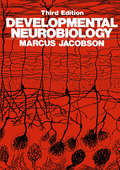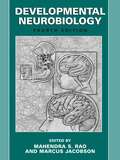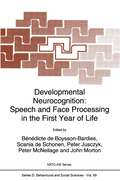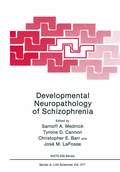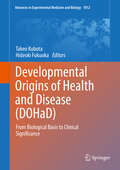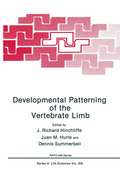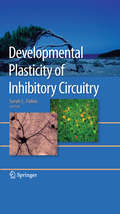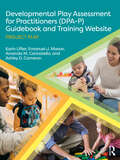- Table View
- List View
Developmental Instability: Proceedings of the International Conference on Developmental Instability: Its Origins and Evolutionary Implications, Tempe, Arizona, 14–15 June 1993 (Contemporary Issues in Genetics and Evolution #2)
by T. A. MarkowDevelopmental Instability: Its Origins and Evolutionary Implications is a collection of papers and transcribed discussions from a conference held in Tempe, Arizona in June 1993. The papers represent a wide range of contributions, from the empirical to the theoretical, and include methods for measuring developmental instability across a variety of taxa and traits. This volume presents contrasting views on how to assess developmental instability as well as on the relationship of instability to genotypic factors, environmental factors and the action of natural and sexual selection. Readers will derive a working knowledge of the best way to assess developmental instability and will be able to design future work in an authoritative way.
Developmental Juvenile Osteology
by Sue Black Craig Cunningham Louise ScheuerDevelopmental Juvenile Osteology was created as a core reference text to document the development of the entire human skeleton from early embryonic life to adulthood. In the period since its first publication there has been a resurgence of interest in the developing skeleton, and the second edition of Developmental Juvenile Osteology incorporates much of the key literature that has been published in the intervening time. The main core of the text persists by describing each individual component of the human skeleton from its embryological origin through to its final adult form. This systematic approach has been shown to assist the processes of both identification and age estimation and acts as a core source for the basic understanding of normal human skeletal development. In addition to this core, new sections have been added where there have been significant advances in the field. Identifies every component of the juvenile skeleton, by providing a detailed analysis of development and ageing and a detailed description of each bone in four ways: adult bone, early development, ossification and practical notes New chapters and updated sections covering the dentition, age estimation in the living and bone histology An updated bibliography documenting the research literature that has contributed to the field over the past 15 years since the publication of the first edition Heavily illustrated, including new additions
Developmental Neurobiology
by Elliott M. BlassIn our attempts to interrogate Nature about the development of the nervous system, we ask such questions as "How do the nerve cells originate and how do the correct types of cells differentiate at their correct positions; how do the neurons link together to form circuits whose functions are properly coordinated; and how are the functions of nerve cells related to behavior, to thought, and to conscious ness?" Those problems are intellectually challenging, not only because solving them would give us practical advantages but also because while they remain unsolved they stimulate the imagination and challenge the intelligence. It is precisely because they are difficult and controversial and have defied complete solution that such problems continue to attract subtle minds. The understanding that we now have of neural ontogeny seems to me to be farther from complete knowledge than from total ignorance. Nonetheless, it gives us a slightly elevated position from which to survey the vicissitudes of the past, to appraise our present understanding, and to consider ways in which our knowl edge might develop in the future. The history of this subject affords a particularly piquant illustration of Arthur Lovejoy's comment that the "adequate record of even the confusions of our forebears may help, not only to clarify those confu sions, but to engender a salutary doubt whether we are wholly immune from different but equally great confusions.
Developmental Neurobiology
by Marcus JacobsonThis consistent and well-illustrated text is an up-to-date survey of cellular and molecular events contributing to the assembly of the vertebrate nervous system. Chapters include a mixture of historical content and descriptions from literature that best illustrate specific aspects of development.
Developmental Neurobiology
by Marcus Jacobson Mahendra S. RaoThis consistent and well-illustrated text is an up-to-date survey of cellular and molecular events contributing to the assembly of the vertebrate nervous system. Chapters include a mixture of historical content and descriptions from literature that best illustrate specific aspects of development.
Developmental Neurobiology of the Autonomic Nervous System (Contemporary Neuroscience)
by Phyllis M. GootmanThis book, covering many key aspects of autonomic nervous system maturation, was suggested by the success of a symposium on the developing autonomic nervous system held at the Spring 1982 meeting of the Federation of American Scientists for Experi mental Biology (Federation Proceedings 1983, 42, 1609). It was obvi ous from the F ASEB symposium that there is increasing interest in the developing autonomic nervous system, particularly with respect to its role in regulating visceral function. Some additional topics that were not covered in the F ASEB symposium are also included in this book. The editor feels that the readers of this volume are, in all probability, already cognizant of the state of knowledge of the adult autonomic nervous system. Therefore, a review of classical autonomic physiology, pharmacology, and neuroanatomy is not provided. For a recent detailed discussion of the ontogeny and phylog eny of the developing nervous system, I would recommend the book published not long ago by D. Purves and J. W. Lichtman, Principles of Neural Development (Sinauer, Sunderland, MA, 1985). Another recent book, Autonomic Nerve Funtion in the Vertebrates by F. Nilsson (Springer-Verlag, New York, 1984), presents a compar ative examination of autonomic nervous system function in verte brates. For a summary of recent advances in the many aspects of catecholamines as they bear on autonomic nervous system re search, I would recommend the series of three books edited by E.
Developmental Neurobiology of Vision (Nato Science Series A: #27)
by R. D. FreemanThis volume contains summaries of most of the invited presentations given by lecturers and participants at the NATO Advanced Study Institute, "Develop mental Neurobiology of Vision," held in Rethymnon, Crete, Greece 18-27 Sep tember 1978. The purpose of this meeting was to enable a relatively small international group of scientists and students to hold discussions and to present their views on current problems in the field. It was intended that the results of the exchanges would be conveyed to others in the native countries of the parti cipants. An attempt was made to obtain broad representation of disciplines within the area of the Institute and this is reflected in the diversity of the chapters in this book. Considerable interest has been generated in recent years concerning the development and plasticity of vision. Perhaps not unexpectedly, along with the high level of activity in this field, there have been so me controversial findings.
Developmental Neurocognition: Speech and Face Processing in the First Year of Life (NATO Science Series D: #69)
by JohnMorton PeterMcNeilage PeterJusczyk ScaniaSchonen BénédicteBoysson-BardiesThis volume contains the proceedings of a NATO Advanced Research Workshop (ARW) on the topic of "Changes in Speech and Face Processing in Infancy: A glimpse at Developmental Mechanisms of Cognition", which was held in Carry-Ie-Rouet (France) at the Vacanciel "La Calanque", from June 29 to July 3, 1992. For many years, developmental researchers have been systematically exploring what is concealed by the blooming and buzzing confusion (as William James described the infant's world). Much research has been carried out on the mechanisms by which organisms recognize and relate to their conspecifics, in particular with respect to language acquisition and face recognition. Given this background, it seems worthwhile to compare not only the conceptual advances made in these two domains, but also the methodological difficulties faced in each of them. In both domains, there is evidence of sophisticated abilities right from birth. Similarly, researchers in these domains have focused on whether the mechanisms underlying these early competences are modality-specific, object specific or otherwise.
Developmental Neuroendocrinology (Masterclass in Neuroendocrinology #9)
by Susan Wray Seth BlackshawIn this book, experts in the field discuss the latest research in developmental neuroendocrinology. Given that the hypothalamus is the center of neuroendocrine activity, the reader will learn about the molecular specification of hypothalamic cells, developmental modulators and epigenetic factors influencing hypothalamic development, and the development of neuroendocrine circuits. Each chapter provides a concise review of the current and future perspectives in developmental neuroendocrinology. Important insights into state-of-the-art techniques applied to functional circuit tracking, lineage tracing of hypothalamic cells, and the identification of genes altered through epigenetic mechanisms are also provided. Given its scope, the book will appeal to all students and researchers who are eager to understand the processes involved in hypothalamus development and the establishment of neuroendocrine circuits. This is the ninth volume in the International Neuroendocrine Federation (INF) Masterclass in Neuroendocrinology series* that aims to illustrate highest standards and encourage the use of the latest technologies in basic and clinical research and hopes to provide inspiration for further exploration into the exciting field of neuroendocrinology. *Volumes 1-7 published by Wiley.
Developmental Neuropathology
by Reinhard L. FriedeThe present text was envisioned as a supplement to eXlstmg texts on human neuropathology, covering only those aspects of pediatric neuropathol ogy which pertain to and are peculiar of the immature nervous system. No coverage-or only brief comment-is given to diseases commonly found in adults which may, on occasion, occur in childhood or infancy as well. The subject matter is divided into three main categories: 1. The "acquired" lesions dating to the fetal, perinatal or early postnatal periods, 2. the malformations, and 3. the heritable metabolic defects. The first 6 chapters (2-7) are reserved to the lesions most intimately linked to the circumstances of birth. There is some inherent ambiguity in distinguishing between "acquired" lesions and malformations, as, indeed, no sharp distinction can be made between one and the other. Many malformations result from diseases acquired during fetal life and their peculiarity resides in the fact that the organ becomes affected before its development terminates and in such a way that its subsequent development becomes deranged or partly abrogated. A variety of causes acting at the same developmental period or over a common pathogenetic mechanism may produce the same type of derangement, including chemical, physical, infectious or genetic factors, as pointed out repeatedly in the text. Consequently, the definition of a malformation, as differing from an "acquired" residual lesion was made dependant on evidence for the derangement of developmental pro cesses subsequent to the acquisition of the disease.
Developmental Neuropathology
by Reinhard L. FriedeI was gratified by the most favorable reception and wide usage received by the first edition of this book. A decade seems to be a short period for a book on pathology, and yet it witnessed many important changes of concepts, along with a formidable growth of knowledge. The second edition required extensive reorganization. There are new chapters on mitochondriopathies, on peroxisomal diseases and on spongy myelino pathies. Major revisions and new additions were necessary in many chapters, for instance those on the dysplasias of the cerebral and of the cerebellar hemispheres, which were largely reorganized. The chapters on perinatal pathology were reordered and reorganized to give a more logical sequence of prenatal, perinatal and postnatal lesions. The entire text was worked over for brevity. A wealth of new references was added with the. aim of staying abreast with the literature up to summer 1988. All refer ences were double checked for errors. My gratitude goes to Mrs. Gisela Ropte and Mrs. Cynthia Bunker for their untiring, diligent help. As a result, this second edition is an essentially rewritten text. Advance in the prevention of human suffering is based on a thorough understand ing of the nature of disease. I hope that this text will continue to be of service in this behalf. Perhaps it may also reflect and foster the intellectual curiosity which makes the "reading of brains" so interesting an occupation. Gottingen, 1989 Reinhard L.
Developmental Neuropathology (International Society of Neuropathology Series)
by Francoise Gray Katy KeohaneA definitive, clinically oriented guide to the pathology of genetics of developmental neuropathology Developmental neuropathology relates to the wide range of disorders affecting the developing brain or pre- and post-natal life, with emphasis on the genetic and molecular mechanisms involved. This book provides a practical guide to diagnosing and understanding these disorders affecting this vulnerable population and potentially stimulates further advances in this exciting area. It also addresses the controversies in inflicted head injury in infants. The fourth major title to be approved by the International Society of Neuropathology (ISN), Developmental Neuropathology offers in-depth chapter coverage of brain development; chromosomal changes; malformations; secondary malformations and destructive pathologies; developmental vascular disorders; acquired metabolic and exogenous toxins; metabolic disorders; Rett syndrome and autism; and infectious diseases. The text provides: Clinical, disease-oriented approach to the pathology and genetics developmental neuropathology Fuses classical and contemporary investigative approaches Includes genetic and molecular biological pathogeneses Fully illustrated Approved and endorsed by International Society of Neuropathology Developmental Neuropathology is the perfect book for practicing neuropathologists, pediatric pathologists, general pathologists, neurologists, and geneticists in deciphering the pathology and pathogenesis of these complex disorders affecting the nervous system of the embryo, fetus, and child.
Developmental Neuropathology
by Francoise Gray Katy KeohaneA definitive, clinically oriented guide to the pathology of genetics of developmental neuropathology Developmental neuropathology relates to the wide range of disorders affecting the developing brain or pre- and post-natal life, with emphasis on the genetic and molecular mechanisms involved. This book provides a practical guide to diagnosing and understanding these disorders affecting this vulnerable population and potentially stimulates further advances in this exciting area. It also addresses the controversies in inflicted head injury in infants. The fourth major title to be approved by the International Society of Neuropathology (ISN), Developmental Neuropathology offers in-depth chapter coverage of brain development; chromosomal changes; malformations; secondary malformations and destructive pathologies; developmental vascular disorders; acquired metabolic and exogenous toxins; metabolic disorders; Rett syndrome and autism; and infectious diseases. The text provides: Clinical, disease-oriented approach to the pathology and genetics developmental neuropathology Fuses classical and contemporary investigative approaches Includes genetic and molecular biological pathogeneses Fully illustrated Approved and endorsed by International Society of Neuropathology Developmental Neuropathology is the perfect book for practicing neuropathologists, pediatric pathologists, general pathologists, neurologists, and geneticists in deciphering the pathology and pathogenesis of these complex disorders affecting the nervous system of the embryo, fetus, and child.
Developmental Neuropathology of Schizophrenia (Nato Science Series A: #217)
by Sarnoff A. Mednick Tyrone D. Cannon Christopher E. Barr Jose M. LaFosseThis volume reports the proceedings of a NATO Advanced Workshop held in Castelvecchio Pas coli, Italy, from August 28 - September 1, 1989. An important inspiration for this Workshop came from our studies in Helsinki and Denmark, which have found that exposure to an influenza epidemic during the second trimester of fetal development increases the risk of adult schizophrenia. This finding has stimulated an important new hypothesis in the study of the etiology of schizophrenia. It has suggested the possiblity that disturbances of brain development during gestation may contribute to the risk of adult schizophrenia. We determined that it would be of value to bring together schizophrenia researchers and those doing basic studies of the development of the brain. Both groups of researchers were encouraged to communicate at a level that would help other scientists to integrate their knowledge and techniques into their own discipline. For this reason, perhaps, the papers of this volume are remarkably clear and not difficult to understand. The first four chapters describe the neurochemical and structural aspects of brain development. The chapter by Dziegielewska and Saunders discusses transport mechanisms and the properties of endogenous and exogenous substances that control the internal environment of the developing brain. In the second chapter, Nowakowski reports on his studies of the develop ment of the hippocampus in mice genetically inbred to exhibit disruptions of neural migration.
Developmental Neuropsychiatry
by Eric TaylorSeveral alterations of brain function cause common mental problems in young people. ADHD, autism, tic disorders, learning difficulties, intellectual disability, and the psychotic disorders of young people are conventionally classified and described as discrete neuropsychiatric problems. Research, however, has made it clear that they are complex, variable, dimensional, overlapping, and that they frequently coexist and share aetiological influences. Developmental Neuropsychiatry explores how clinicians often find themselves confronted with complex problems of diagnosis and treatment. Existing texts and guidelines, however, continue to be organized around simple conceptualization of illness categories. The book provides unified accounts of the complex psychiatric, psychological, neurological, medical, social, and educational issues that are relevant to clinical understanding.
Developmental Neuropsychiatry
by Eric TaylorSeveral alterations of brain function cause common mental problems in young people. ADHD, autism, tic disorders, learning difficulties, intellectual disability, and the psychotic disorders of young people are conventionally classified and described as discrete neuropsychiatric problems. Research, however, has made it clear that they are complex, variable, dimensional, overlapping, and that they frequently coexist and share aetiological influences. Developmental Neuropsychiatry explores how clinicians often find themselves confronted with complex problems of diagnosis and treatment. Existing texts and guidelines, however, continue to be organized around simple conceptualization of illness categories. The book provides unified accounts of the complex psychiatric, psychological, neurological, medical, social, and educational issues that are relevant to clinical understanding.
The Developmental Neurotoxicity of Lead
by C. WinderOver the past two millennia environmental lead levels have risen dramatically (Patterson, 1980). Most of this increase has occurred since the beginning of the present century (Murozami et 01. , 1969), and taken into perspective, a typical individual living in the industrialized world sustains a lead burden 500 times that of his prehistoric ancestors (Patterson, 1983). Lead is unique in being an environmental pollutant where the levels deemed clinically toxic are less than an order of magnitude from those that are normally encountered in the population. The clinical limit for lead exposure, 70 JLg Pb/tOO ml blood, is about three times the 'normal' value (in the range 15-30 JLg Pb/100ml blood). This small difference is remarkable from the toxicological standpoint. The key concept here is control of dis persal. The industrial actions of man bring contact with a wide variety of substances, some of which are poisonous or dangerous. In such cases pro tective measures are taken to keep hazardous exposure to a minimum. In the of lead compounds, stringent regulations are production and distribution enforced. The exception to this is in the dispersal of lead from vehicle exhausts following purchase from the petrol pump. Perhaps man's long standing acquaintance with lead in home and industry is responsible for a complacency which until only recently has been unquestioned. Beginning in the late 1960s, evidence began to accumulate suggesting that lead at relatively low levels of exposure might be causing negative effects on neurobiological function.
Developmental Origins of Health and Disease: From Biological Basis to Clinical Significance (Advances in Experimental Medicine and Biology #1012)
by Takeo Kubota Hideoki FukuokaThis book addresses the developmental origins of health and disease (DOHaD), a new medical concept that demonstrates that various adult diseases start in the fetal period. It discusses our current understanding of the molecular mechanisms of DOHaD, including gene body epigenetics and non-coding RNA, and comprehensively examines diseases such type 2 diabetes, a well known as standard DOHaD-associated disease, as well as non-alcoholic fatty liver disease, hypertension and neurodevelopmental disorders. It argues that most adult diseases start at a very early stage, such as in the fetal and neonatal periods, and that earlier prevention and intervention would result in better outcomes for adult diseases such as type 2 diabetes and cardiac disorders, which are increasing in both developed and developing countries. The book appeals to obstetricians and pediatricians, as well as physicians who treat adult patients, wanting to understand the origins of diseases.
Developmental Patterning of the Vertebrate Limb (Nato Science Series A: #205)
by J. Richard Hinchliffe Juan M. Hurle Dennis SummerbellFollowing pioneering work by Harrison on amphibian limbs in the 1920s and by Saunders (1948) on the apical ridge in chick limbs, limb development became a classical model system for investigating such fundamental developmental issues as tissue interactions and induction, and the control of pattern formation. Earlier international conferences, at Grenoble 1972, Glasgow 1976,and Storrs, Connecticut 1982, reflected the interests and technology of their time. Grenoble was concerned with ectoderm-mesenchyme interaction, but by the time of the Glasgow meeting, the zone of polarizing activity (ZPA) and its role in control of patterning was the dominant theme. Storrs produced the first intimations that the ZPA could be mimicked by retinoic acid (RA), but the diversity of extracellular masrix ~olecules,particularly in skeletogenesis,was the main focus of attention. By 1990, the paradigms had again shifted. Originally, the planners of the ARW saw retinoic acid (as a possible morphogen controlling skeletal patterning), the variety of extracellular matrix components and their roles, and the developmental basis of limb evolution as the leading contemporary topics. However, as planning proceeded, it was clear that the new results emerging from the use of homeobox gene probes (first developed to investigate the genetic control of patterning of Drosophila embryos) to analyse the localised expression of "patterning genes" in limb buds would also be an important theme.
Developmental, Physiological, and Functional Neurobiology of the Inner Ear (Neuromethods #176)
by Andrew K. GrovesThis volume explores the latest techniques in inner ear development, analysis of its sensory cells, and characterization and manipulation of the central auditory and vestibular pathways. The chapters in this book cover topics such as dissection and imaging of the cochlea; behavioral evaluation of animal models of diseases like tinnitus; hair cell function and regeneration; and recent advances in sequencing technology. In the Neuromethods series style, chapters include the kind of detail and key advice from the specialists needed to get successful results in your laboratory. Cutting-edge and comprehensive, Developmental, Physiological, and Function Neurobiology of the Inner Ear is a valuable resource for scientists and researchers interested in learning more about this developing field.
Developmental Plasticity of Inhibitory Circuitry
by Sarah L. PallasNeuroscience has long been focused on understanding neural plasticity in both development and adulthood. Experimental work in this area has focused almost entirely on plasticity at excitatory synapses. A growing body of evidence suggests that plasticity at inhibitory GABAergic and glycinergic synapses is of critical importance during both development and aging. The book brings together the work of researchers investigating inhibitory plasticity at many levels of analysis and in several different preparations. This topic is of wide relevance across a number of different areas of research in neuroscience and neurology. Medical problems such as epilepsy, mental illness, drug abuse, and movement disorders can result from malfunctioning inhibitory circuits. Further, the maturation of inhibitory circuits may trigger the onset of critical periods of neural circuit plasticity, raising the possibility that such plastici periods could be reactivated for medical benefit by manipulating inhibitory circuitry.
Developmental Play Assessment for Practitioners (DPA-P) Guidebook and Training Website: Project Play
by Karin Lifter Emanuel J. Mason Amanda M. Cannarella Ashley D. CameronDevelopmental Play Assessment for Practitioners (DPA-P) Guidebook and Training Website: Project Play offers a comprehensive assessment of naturally occurring play activities for evaluating young children’s developmental progress accurately, so that useful interventions can take place as early as possible. It can be used by practitioners in a wide range of educational and therapeutic settings and is designed to support developmental progress through planning interventions in play, and using what we know about a child’s progress in play to plan play-based interventions in cognition, language, motor, social-emotional, and self-help skills. The guidebook and training website provide a comprehensive introduction to how to successfully use the assessment with infants, toddlers, and young children with disabilities or at risk for disabilities. The comprehensive guidebook offers an overview of the DPA-P and Project Play, defines play, discusses the background literature on play, and explains why this assessment is needed. Clear guidance helps practitioners and family members understand play, how to evaluate play, and how to use play for different purposes. The guidebook offers: an introduction to the comprehensive training website and how to use it understanding of the categories of play assessed and their definitions guidance on how to administer the assessment and prepare a summary evaluation of a child’s performance clear instructions for the coding sheets and scoring guidelines for constructing sets of toys guidance on taking the results of the DPA-P evaluation of a child’s progress in play to develop a plan of activities for intervention explanation of how you evaluate activities at the absence, basic, emergence, and mastery levels for developing a plan suggestions for assembling sets of toys for intervention, based on toys available in children’s homes and early childhood settings procedures for facilitating or teaching play activities to children who are developing more slowly than their peers technical aspects of the assessment To make the DPA-P as flexible as possible for all practitioners, it also offers guidance on adaptations for administering the test, in the coding sheets, with toys to enhance cultural appropriateness for gathering the observations, and for supporting interventions in play. The Developmental Play Assessment for Practitioners (DPA-P) can be used in natural settings and takes 30 minutes to complete. It is a valuable tool for all those who serve, or are training to serve, young children in early childhood settings, schools, service agencies, colleges, and universities. It will be of great benefit for early intervention personnel, speech-language pathologists, physical therapists, occupational therapists, and psychologists.
Developmental Play Assessment for Practitioners (DPA-P) Guidebook and Training Website: Project Play
by Karin Lifter Emanuel J. Mason Amanda M. Cannarella Ashley D. CameronDevelopmental Play Assessment for Practitioners (DPA-P) Guidebook and Training Website: Project Play offers a comprehensive assessment of naturally occurring play activities for evaluating young children’s developmental progress accurately, so that useful interventions can take place as early as possible. It can be used by practitioners in a wide range of educational and therapeutic settings and is designed to support developmental progress through planning interventions in play, and using what we know about a child’s progress in play to plan play-based interventions in cognition, language, motor, social-emotional, and self-help skills. The guidebook and training website provide a comprehensive introduction to how to successfully use the assessment with infants, toddlers, and young children with disabilities or at risk for disabilities. The comprehensive guidebook offers an overview of the DPA-P and Project Play, defines play, discusses the background literature on play, and explains why this assessment is needed. Clear guidance helps practitioners and family members understand play, how to evaluate play, and how to use play for different purposes. The guidebook offers: an introduction to the comprehensive training website and how to use it understanding of the categories of play assessed and their definitions guidance on how to administer the assessment and prepare a summary evaluation of a child’s performance clear instructions for the coding sheets and scoring guidelines for constructing sets of toys guidance on taking the results of the DPA-P evaluation of a child’s progress in play to develop a plan of activities for intervention explanation of how you evaluate activities at the absence, basic, emergence, and mastery levels for developing a plan suggestions for assembling sets of toys for intervention, based on toys available in children’s homes and early childhood settings procedures for facilitating or teaching play activities to children who are developing more slowly than their peers technical aspects of the assessment To make the DPA-P as flexible as possible for all practitioners, it also offers guidance on adaptations for administering the test, in the coding sheets, with toys to enhance cultural appropriateness for gathering the observations, and for supporting interventions in play. The Developmental Play Assessment for Practitioners (DPA-P) can be used in natural settings and takes 30 minutes to complete. It is a valuable tool for all those who serve, or are training to serve, young children in early childhood settings, schools, service agencies, colleges, and universities. It will be of great benefit for early intervention personnel, speech-language pathologists, physical therapists, occupational therapists, and psychologists.
Developmental Psychobiology (Handbooks of Behavioral Neurobiology #13)
by Elliott M. BlassELLIOTT M. BLASS Fifteen years have passed since the first volume on developmental psychobiology (Blass, 1986) appeared in this series and 13 since the publication of the second volume (Blass, 1988). These volumes documented the status of the broad domain of scientific inquiry called developmental psychobiology and were also written with an eye to the future. The future has been revolutionary in at least three ways. First, there was the demise of a descriptive ethology as we had known it, to be replaced first by sociobiology and later by its more sophisticated versions based on quantitative predictions of social interactions that reflected relatedness and inclu sive fitness. Second, there was the emergence of cognitive science, including cogni tive development, as an enormously strong and interactive multidisciplinary effort. Making the "functional" brain more accessible made this revolution all the more relevant to our discipline. In the laboratory, immunocytochemical detection of immediate / early genes, such as los, now allows us to trace neuronal circuits activated during complex behaviors. The "functional" brain of primates, especially humans, was also made very accessible through neuroimaging with which we can look at and into brains as they solve and attempt to solve particular tasks. Those of us who were trained in neurology as graduate students two or three decades ago recognize only the people in white coats and patients in beds or on gurneys when we visit neurologi cal units today. The rest is essentially new.
Developmental Psychobiology and Behavioral Ecology (Handbooks of Behavioral Neurobiology #9)
by Elliott M. BlassThe previous volume in this series (Blass, 1986) focused on the interface between developmental psychobiology and developmental neurobiology. The volume emphasized that an understanding of central nervous system development and function can be obtained only with reference to the behaviors that it manages, and it emphasized how those behaviors, in tum, shape central development. The present volume explores another natural interface of developmental psy chobiology; behavioral ecology. It documents the progress made by developmental psychobiologists since the mid-1970s in identifying capacities of learning and con ditioning in birds and mammals during the very moments following birth-indeed, during the antenatal period. These breakthroughs in a field that had previously lain dormant reflect the need to "meet the infant where it is" in order for behavior to emerge. Accordingly, studies have been conducted at nest temperature; infants have been rewarded by opportunities to huddle, suckle, or obtain milk, behaviors that are normally engaged in the nest. In addition, there was rejection of the exces sive deprivation, extreme handling, and traumatic manipulation studies of the 1950s and 1960s that yielded information on how animals could respond to trauma but did not reveal mechanisms of normal development. In their place has arisen a series of analyses of how naturally occurring stimuli and situations gain control over behavior and how specifiable experiences impose limitations on subsequent development. Constraints were identified on the range of interactions that remained available to developing animals as a result of particular events.



